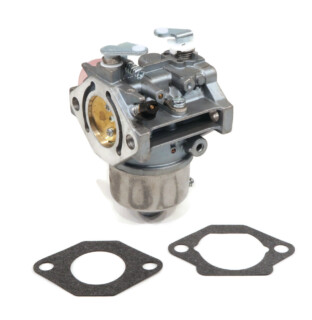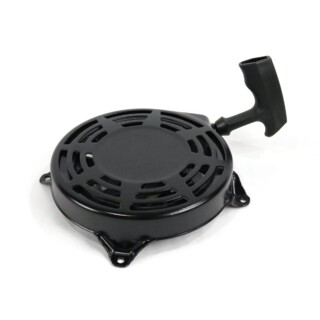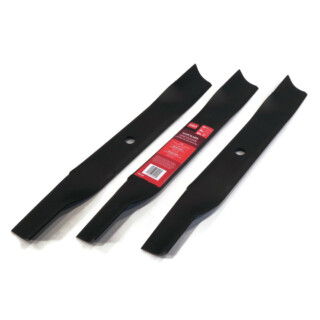
Mower Troubleshooting Guide: Find and Fix the Problem
Running into issues with your lawnmower can quickly put a damper on your day. What should have been a relaxing mowing session is now fraught with frustration as you try to determine what’s wrong with your mower.
Fortunately, The ROP Shop is here for you with this mower troubleshooting guide. Jump directly to the issue you’re experiencing (and the accompanying mower repair recommendations) by clicking one of the links below.
Don’t forget to remove your mower’s spark plug before attempting any in-depth repairs.
Lawnmower won’t start/won’t stay running
Lawnmower vibrates when running
Lawnmower’s starter rope won’t pull
Lawnmower backfires (or afterfires)
If you find that you need to replace some parts in your mower, check out our article on where to find your mower's serial and model number. It'll come in handy when searching for the correct parts.
Lawnmower won’t start or won’t stay running

You’re all geared up for a good mowing session, you start your mower, it roars to life…and then dies—or it just doesn’t start at all.
There are several reasons this could happen. We recommend starting with the more affordable and easier repairs.
Low on gas
Don’t jump right to the worst-case scenario. It could just be that it’s been a while since you’ve filled the gas tank.
Check your fuel level and add more if needed.
(Make sure you’re using fuel with less than 10% ethanol, or you could be harming your mower’s engine.)
Bad battery
If you’re one of the folks with a battery-powered mower, don’t forget to keep your battery charged.
Also, ensure that all connectors are tight and that the terminals haven’t corroded.
Carburetor failure
This is the most typical reason your lawnmower starts and then fails.
Fortunately, if you have a dirty carburetor that’s causing your engine to stop, it’s a repair that you can make on your own. Read our blog on cleaning a carburetor.
If you need to replace your carb, check out our lawnmower carburetors and carburetor kits.
Faulty spark plug
A worn or damaged spark plug can prevent your mower from working properly.
Carefully remove your spark plug and use a wire brush to clean off any dirt that’s accumulated on it. However, if you see really heavy deposits of gunk or notice scrapes or cracks, it’s time for a spark plug replacement.
Clogged air filter
Air filters are there to screen your engine from dirt and debris that could clog it. The problem is, once your filter has collected all that debris, it’ll make it more difficult for your engine to get the air it needs to function.
This is why keeping your air filter clean is essential.
If your lawnmower has a foam air filter, you can clean it with soap and water. Let it fully dry before re-installing it.
Paper air filter? Simply replace it, as it can’t be cleaned.
Clogged fuel cap
It’s possible that even with a full fuel tank, your mower’s engine doesn’t have proper gas supply.
As fuel is drained from the tank, air should be coming in through the fuel cap to fill the space in the tank and prevent a vacuum from forming. However, if this doesn’t happen, gas will stop flowing.1
You can test this by opening your fuel cap a little. If your mower runs properly when that happens, then you have a clog in your fuel cap vent. Fortunately, you can replace your fuel cap to fix this issue.1
Don’t stop there, however. Dirt that’s gotten into your fuel cap can lead to a plugged tank or fuel filter. This means that if you do find clogs in your cap, you’ll want to check your entire fuel system in this order: cap, tank, fuel line, filter, pump, and carburetor.
If you find dirt that made its way to the carburetor, it’s likely your entire fuel system has become compromised.





Lawnmower vibrates when running
Were your blades sharpened recently? It’s possible they weren’t balanced properly afterward, causing that shaking sensation.
Learn more about sharpening your mower blades.
Poor cut quality
If you notice your grass doesn’t look as nice as it normally does when you’re mowing, it’s possible that you’re due for some routine mower maintenance tasks.
It could be that grass buildup is making it difficult for your mower to get a clean cut. In that case, you’ll want to clean your mower deck.
Also, make sure that your mower blades haven’t gone dull and that your tires are properly inflated.

Lawnmower is smoking
If smoke is coming out of your lawnmower, use the color of the smoke to help you identify the problem.
Blue or white smoke
This is an indication that you have oil on the engine. This could be from overfilling your oil reservoir or because you spilled oil on your engine. If the former, simply drain some of it; if the latter, you can allow that fuel to simply burn off.2
Using your lawnmower on a slope or tilting it the wrong way for maintenance to cause such spills, so take care to prevent this problem in the future.
Once you’ve taken the proper steps to solve this problem, clean or replace your spark plug, as it will have been collecting burned oil residue.3
Black smoke
If the smoke is black, it’s a sign that your mower is burning too much gas and that your carburetor can’t get enough air. This could be because your air filter is clogged, so clean it out and see if that resolves the problem.2
If the smoking persists, there are a few other potential causes, such as issues with your oil seals, a cracked crankcase, or a clogged carburetor. If it’s the last of these, you can fix the problem yourself. However, for the others, you might want to take your lawnmower in to a professional to correct the issue. 2
Lawnmower’s starter rope won’t pull
It can be disconcerting to try to pull your mower’s starter rope only to find that nothing happens.
However, instead of continuing to yank on the rope in vain like a madman, consider one of these potential causes.
Physical obstruction of the blades

There are all sorts of things that could stop your mower blades from being able to turn, thereby preventing the starter rope from pulling.
Tip your mower over to begin your search; just be sure that you’re tipping it in such a way that you won’t cause oil spills.
Check your mower deck for sticks, rocks, or other debris that could be blocking the blade. The cause could even be another part of your mower, such as a broken shroud or a debris shield that got pulled out of place.4
It’s also possible that your blades became bent so that they keep hitting your mower deck instead of spinning smoothly. If this is the case, you’ll need to replace your blade.4
Seized engine
Check for a seized engine by trying to turn the blades by hand. Wear work gloves while you do this to prevent injury. If the blades simply won’t turn, there are several steps you can take, depending on what you think the cause is: 4
- Low oil
- Top off oil reservoir and rock the blades back and forth to loosen.
- If needed, spray a lubricant through the spark plug hole.
- Spray engine starter into the spark plug hole and then reinstall the spark plug.
- Excess oil or oil in the cylinder head
- Remove spark plug and pull starter until no oil comes out through the hole.
- Spray engine starter and reinstall the spark plug.
- Pull the starter and let the engine run for a while, topping off the oil if needed.
- Vapor locking (usually from a very hot engine or a lack of fuel in the tank)
- Allow the engine to cool down, fill the fuel tank, and restart.
- Use a fuel stabilizer.
- Don’t run your mower for too long at a time.
Recoil starter issue
If none of those fixes work, the issue may lie with your recoil starter.
You’d have to remove the starter from your mower to test it, but if you do, this will allow you to pull it and spot any potential issues in the mechanism. This includes knots in the rope or obstructions elsewhere in the starter. You may find that the entire starter needs to be replaced.4





Lawnmower backfires (or afterfires)
It’s not very enjoyable for your mower to spit little explosions at you while it’s running or shutting down (backfiring) or when it has just shut off (afterfiring).
Here are some potential solutions from Briggs & Stratton:
Backfiring
- Bring your engine speed down slowly instead of all at once.
- Use a recommended fuel for your engine and avoid fuel brands that use a lot of alcohol in their blend.
- Adjust your carburetor so your mower isn’t running too lean.
Afterfiring
- Let the engine cool down by idling it down for 15-30 seconds at the proper speed.
- Make sure the anti-afterfire solenoid is working properly (and if you have one of these solenoids, ensure the engine is at full throttle when you shut it off).
- Try a different brand of fuel.
- Adjust your carburetor.
Final thoughts
A mower malfunction can be a headache, but this guide should help you to identify and fix some of the more common issues yourself.
Don’t forget that proper maintenance can go a long way in preventing issues with your mower, which will in turn save you time and money on repairs or replacements. Check out our mower maintenance blogs for more information.
If you’re still struggling with your lawnmower, you can check out some of our other troubleshooting resources, such as this blog on carburetor and fuel system issues or our FAQ page. You can also contact our customer service department for more help.

Having trouble using your ROP Shop pressure washer surface cleaner? These tips can help you out.

Thinking about getting a pressure washer? Here are eight advantages to owning a pressure washer to help convince you.

Installing a new pressure washer pump doesn’t have to be a hassle. Let The ROP Shop walk you through it.

Ready to learn how to pressure wash quickly, effectively, and safely? Check out these eleven tips.